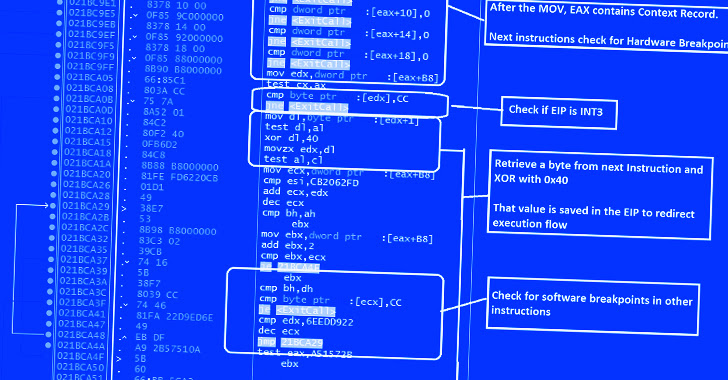Cybersecurity researchers have exposed a wide variety of techniques adopted by an advanced malware downloader called GuLoader to evade security software.
“New shellcode anti-analysis technique attempts to thwart researchers and hostile environments by scanning entire process memory for any virtual machine (VM)-related strings,” CrowdStrike researchers Sarang Sonawane and Donato Onofri said in a technical write-up published last week.
GuLoader, also called CloudEyE, is a Visual Basic Script (VBS) downloader that’s used to distribute remote access trojans on infected machines. It was first detected in the wild in 2019.
In November 2021, a JavaScript malware strain dubbed RATDispenser emerged as a conduit for dropping GuLoader by means of a Base64-encoded VBScript dropper.
A recent GuLoader sample unearthed by CrowdStrike exhibits a three-stage process wherein the VBScript is designed to deliver a next-stage that performs anti-analysis checks before injecting shellcode embedded within the VBScript into memory.
The shellcode, besides incorporating the same anti-analysis methods, downloads a final payload of the attacker’s choice from a remote server and executes it on the compromised host.
“The shellcode employs several anti-analysis and anti-debugging tricks at every step of execution, throwing an error message if the shellcode detects any known analysis of debugging mechanisms,” the researchers pointed out.
This includes anti-debugging and anti-disassembling checks to detect the presence of a remote debugger and breakpoints, and if found, terminate the shellcode. The shellcode also features scans for virtualization software.
An added capability is what the cybersecurity company calls a “redundant code injection mechanism” to avoid NTDLL.dll hooks implemented by endpoint detection and response (EDR) solutions.
NTDLL.dll API hooking is a technique used by anti-malware engines to detect and flag suspicious processes on Windows by monitoring the APIs that are known to be abused by threat actors.
In a nutshell, the method involves using assembly instructions to invoke the necessary windows API function to allocate memory (i.e., NtAllocateVirtualMemory) and inject arbitrary shellcode into memory via process hollowing.
The findings from CrowdStrike also come as cybersecurity firm Cymulate demonstrated an EDR bypass technique known as Blindside that allows for running arbitrary code by using hardware breakpoints to create a “process with only the NTDLL in a stand-alone, unhooked state.”
“GuLoader remains a dangerous threat that’s been constantly evolving with new methods to evade detection,” the researchers concluded.
Read the full article here

